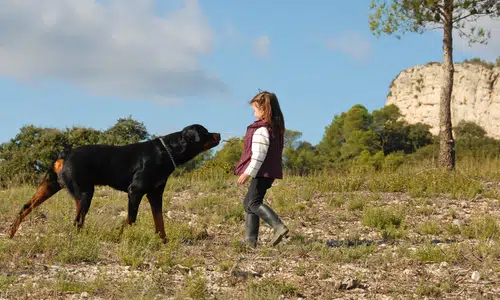Home » Blog » Pet » Pets: Understanding Them » Kids and Dogs: Respecting Each Other’s Boundaries
Categories
Tags
animal welfare
breed profile
buying a car
buying a pet
Car
car accessories
car care
car features
car insurance
Car safety
car sales
car service
cat
cat behaviour
cat body language
Cat Breeds
cat food
cat insurance
comprehensive car insurance
Dog
Dog Behaviour
dog body language
Dog Breeds
dog food
Dog Insurance
dog training
eco friendly cars
Kitten
New Car
pet accessories
pet activities
Pet Adoption
pet breeders
pet days of the year
pet fun stuff
Pet Health
pet insurance
pet parenting
Pet Safety
pet services
Puppy
rescue pets
road safety
road trip
safe driving
Recent Blog:
Facebook Posts
22 hours ago
Are intestinal worms setting up camp in your dog’s gut without paying rent? Here’s how to spot the main culprits and get rid of them too:![]()
![]() Preventing, Identifying and Treating Intestinal Worms in Dogs - bit.ly/43YjCKu
... See MoreSee Less
Preventing, Identifying and Treating Intestinal Worms in Dogs - bit.ly/43YjCKu
... See MoreSee Less
Preventing, Identifying and Treating Intestinal Worms in Dogs
www.pd.com.au
Intestinal worms, such as roundworms in dogs are one of the least glamorous topics on the planet. These intestinal parasites that basically use our dogs
PD Insurance
with Dogs West.
3 days ago
We enjoyed meeting #breeders #doglovers and members at the Dogs West Open Day. Special thanks to our partner Dogs West for organising an incredible event. There is still time to enter our pawsome competition. Click here for details: bit.ly/4covyce![]() #PDinsurance #dogswestopenday #dogswest
... See MoreSee Less
#PDinsurance #dogswestopenday #dogswest
... See MoreSee Less
3 days ago
Did you know? The Manx is a breed that is known for its lack of a tail, which is caused by a genetic mutation.
... See MoreSee Less
‘Kids and dogs’ is a big keyphrase in the news these days. Dog bites continue to result in children being wounded, some scarred and even worse. Sadly, many of these kids may never experience the joy of one day having their own dog because of the painful memories.
Situations like these can and obviously ought to be averted.
As renowned dog whisperer Cesar Millan says, “it’s not the dog, it’s the human behind the dog.” And he’s right. When dogs hurt children, the dogs have inevitably been treated badly, taught bad behaviour, or lack proper training.
Kids and dogs: prevention dog aggression
This is the third in a series of articles where we look at reasons for dog aggression and how to prevent it. Read the first article on dog bites dog where we uncover reasons for dog-on-dog aggression. While in the second piece we look at dog attacks on people and the remedies for it.
In this article, we explore the relationship and boundaries between dogs and kids and how to protect them. Find out more…
Teaching kids and dogs how to be friends
Graduating to parenthood is a big moment. But what happens when you already have a child in the form of a furry four-legged pup? You’ve seen Lady and the Tramp, right? Well unfortunately it’s not all fiction.
When a child comes into the household the dynamics change. So what was first position for your pooch can suddenly be second. A dog who feels threatened can react defensively, which is why teaching them dog obedience from the start is so important.
Whenever family dynamics change, it’s an important time to reassure your dog you love them through lots of time and activities together. This provides a safer space for your kids, both human and furry, to be best buds.
However, this isn’t the only time to teach dogs and kids the guidelines of friendship. Even visiting children can alarm your dog, which is why it’s hyper important that all dogs are socialised properly towards kids.
We socialise our children and dogs in the same environments
At some or other point, every dog has their day when they will meet a kid, whether it’s at the park, a house they visit or their own house. And because dogs are social, they need to be socially adjusted through proper training to cope with this.
Kids are loud, fast and cry, all things which can alarm dogs. Remember that our canine friends have highly developed senses. As a result, they can experience these sounds and movements even more intensely than kids’ very own parents. And that’s saying a lot.
A frightened or startled dog may resort to growling, or even biting in defence. And even if it’s only growling, that can say enough to a small child to give them a lasting impression of dogs. That’s not fair on the child or the dog, which is why building a dog’s confidence around kids is vital.
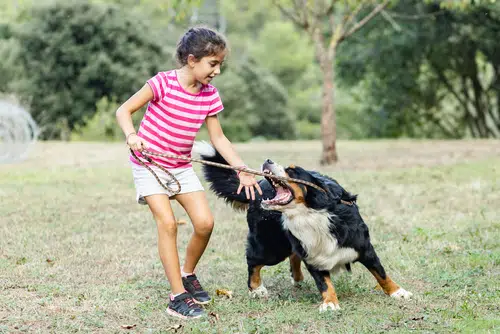
Training your dog to be kid friendly
How do you train your dog to be kid friendly if they haven’t been around kids? That’s the big question, and just like learning to read, it begins with the ABC’s. In other words, you begin slowly by giving your pup the basic groundwork they need.
When your dog sees or meets children you want them to know they’re neither competition nor a threat.
Here are some steps to get started:
- Introduce them to children who are comfortable and familiar with dogs. This will give your dog a good impression of “littler” humans and build confidence.
- Teach them some basic good people manners. This includes teaching your dog not to jump up and not to bite or growl while playing.
- Get your dog accustomed to things kids might do, so they’re not as startled if this happens. For example, tug on their ears gently, or give them a hug. Reward them with praise or treats after and always stop before they become annoyed.
- Consider puppy training school to fast-track dog to human and dog to dog social skills and obedience.
- Until your dog is ready and accustomed to kids, avoid taking them to public spaces where children play. It’s only fair your pup is properly prepped before you do. Stick to dog parks instead.
- Remember that if a dog growls or barks at a child, it’s already crossed an obedience line. It’s better to prevent such a situation from happening until your pup is ready with the skills they need.
The list doesn’t end here…
The above isn’t an exhaustive list, so it’s important to continue your research, especially (but not only) if you’ve a breed of dog known for aggression. Find out more about Australia’s top five favourite dog breeds right now. Or, if you’re researching what breed to get for a family, read our article on the kindest dog breeds.
If you’ve a rescue dog or an older dog who’s not used to kids, consider bringing in a pet behaviourist. Dogs can struggle to overcome trauma just like people do. You want to help them get to that happy place as quickly as possible so they can start socialising. Above all, you want your dog to be safe with kids and people generally.
If yours is still a pup, here are some great puppy training tips to get going with obedience. Training is a great way to use up excess energy and shows your puppy you’re interested and attentive to them.
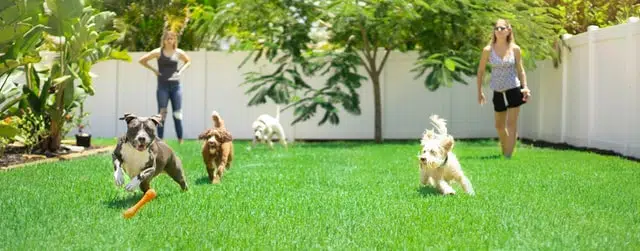
How do you teach kids to interact with dogs?
Raising happy and safe kids in a dog friendly world also means teaching your children about dog boundaries. Even if you don’t own your own dog, you’re bound to encounter them at friends’ houses, on the beach or at the park.
Lots of kid behaviour that’s pure and innocent can nonetheless cause outbursts of energy or sharp reactions in dogs. Giving your child canine social skills so they know what to do and not to do around dogs is in their best interest full stop.
Because after all, we’re instilling inter-species respect and ideally friendship. Here’s a starter list of lessons for kids on canine etiquette.
Supervision
Make it absolutely clear to never approach a dog unless you’re there to supervise. This is especially important in toddlers and younger kids who are at eye level with dogs and who dogs may incorrectly perceive to be threatening.
Avoid eye contact
Following on from the previous point, it’s super important not to stare a dog in the eyes. Your small child who’s at eye level with a dog may inadvertently do this unless they know not to. Dogs perceive direct staring as a challenge. And in fact, so do people. We just know that little kids aren’t trying to threaten us, plus they’re not at our eye level.
Body language
Not all body language means the same thing. For example, a wagging tail in dogs means agitation in cats. Interactions can be confusing for all beings involved. Firstly, teach your kids not to approach a dog from the back or hover over them. Secondly, ensure they move gently around dogs, avoiding sudden movements that could startle them. Thirdly, teach them to not run directly at a dog as this may cause them to react defensively. With this in mind, think about other types of movements you should be showing your kids to avoid.
Voice
Teach children to talk quietly around dogs because they hear much better than we do. Our ordinary chatter is like a mobile phone up against their ear at best. Now think about excited yelling or screaming in protect. Eek.
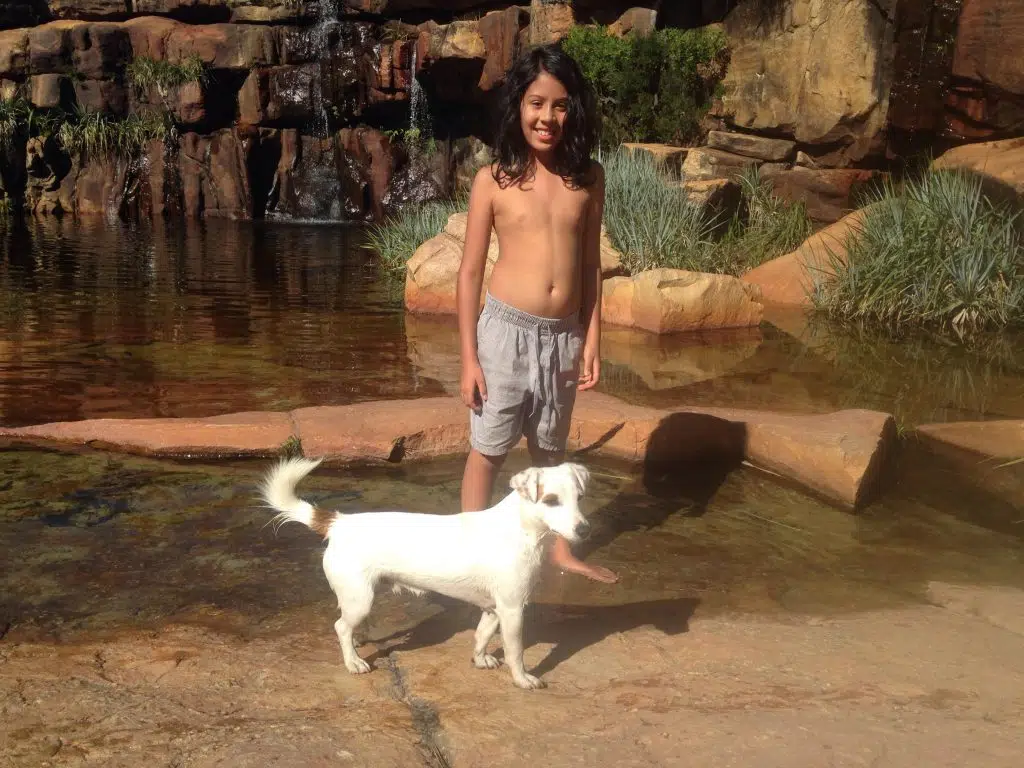
A dog’s body
Let your kids know to never intrude on a dog by pulling on any part of their body, especially the tail, ears and fur. Not because this is worse than pulling any other bits, just that it’s more likely as these are the sticky-out bits.
Saying hello
Teach your kids how and where to pet dogs. Get them familiar with the right way to pet a dog. Ensure they know to never approach one unless they have an adult with them. And they should always ask the owner for permission before patting.
Kid-free zones
All people, kids especially, need to know how to respect a dog’s toys, bed, crate, food bowls, bones, and any other possessions. Dogs are instinctively possessive, so touching their stuff is a direct threat. For example, never approach a dog while they’re eating or chewing on a bone. Also don’t approach a mum dog with her puppies. Make sure kids know these are all off-limits, to help them stay safe.
This is just a list to get you started, but there are ample videos you can watch with your children to get them used to dogs’ needs. To sum it up in Cesar Millan’s words, when you meet a dog for the first time it’s “No touch, no talk, no eye contact.”
Teaching children safety tips is paramount. If understanding a few basic canine behaviours can prevent even one dog bite, then it’s worthwhile.
Kids and dogs: resources for friendship
Building societies where kids and dogs can cohabit safely in all types of situations and contexts doesn’t happen on its own. Learning positive behaviours takes love, support, and special attention.
No matter how adoring a pet parent you are, if you don’t have the time or expertise, consider a puppy school or dog behaviourist. You’ll be giving your dog the lessons to a happy life and helping them to understand not just people, but other dogs too.
What happens when a dog bites a child
When dogs bite children the consequences to the child’s physical and mental wellbeing can be devastating. In addition, dog owners have sometimes been found criminally liable. If a dog does serious damage, they’re often the final victim if they’re euthanised.
The situation can be just as miserable when dogs bite the children in their own households. Although this sounds strange, it can and does happen when dogs feel threatened or we misread them. Get yourself and your kids learned up so you always know the answer to the question “Is my dog afraid?”
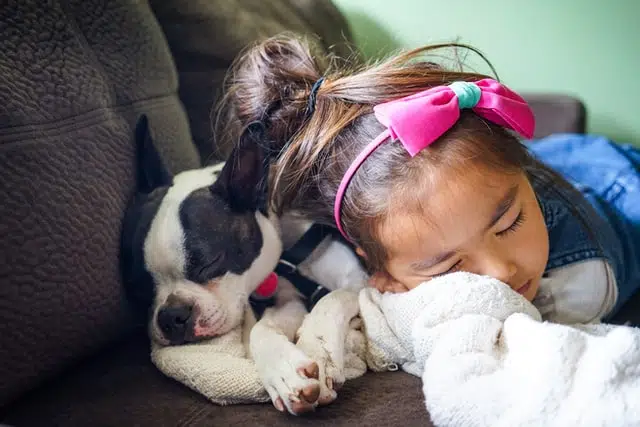
What can I do if my dog doesn’t get along with my kids?
If you feel you’ve tried all the available solutions from trainers to behaviourists and it’s still not working, consider other avenues. It’s important to resolve the situation before your dog bites your child or someone else’s. Prevention is not only better than cure but also necessary.
For example, some people find giving their dog a separate outdoor and sheltered space works. Be sure to visit often. This type of set up requires you to still make ample time available to play with and take your pup out each day, so they don’t experience separation anxiety in pets or resent other family members.
If re-configuring their space at home doesn’t work you may want to consider re-homing your dog with friends or family. Not an option? Perhaps it’s time to look for a reputable shelter. One that does home checks with the dog adoptive families to give pup the best second chance they can have.
In an ideal situation, things won’t ever come to this and you, your kids, other’s kids and your pooch will all always get along great. But because extreme scenarios can and sometimes do happen, knowing what solutions exist can simply be educational or helpful.
Dog health
Dogs who are injured or sick have been known to bite even their most beloved family members in self-defence. People can be defensive when they’re vulnerable too, so we totally get it. It’s easy to keep your pup healthy and on schedule with their vet check-ups with pet insurance.
It doesn’t cost much and can save you loads on medical bills, like for accidents, illnesses, other non-routine vet visits, third party liability, medication, and more.
Share On:

